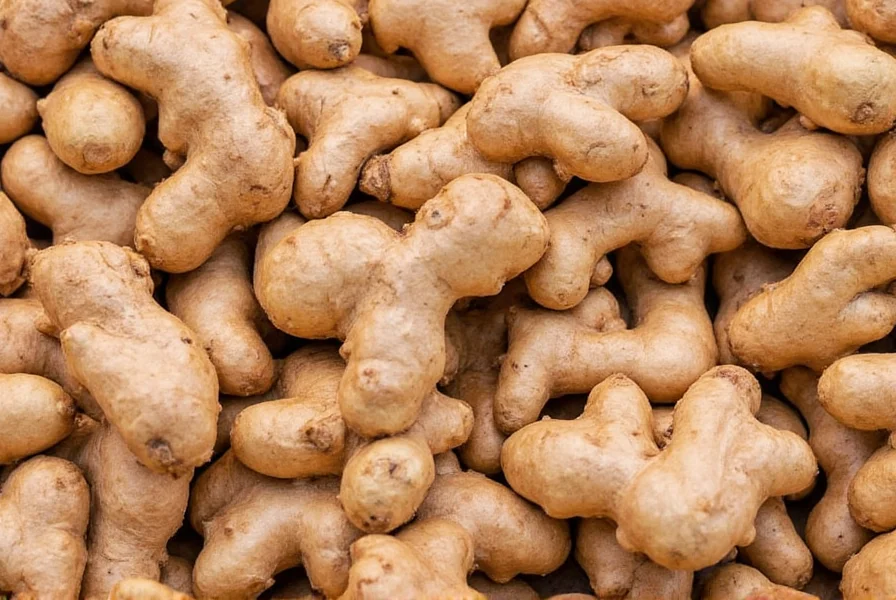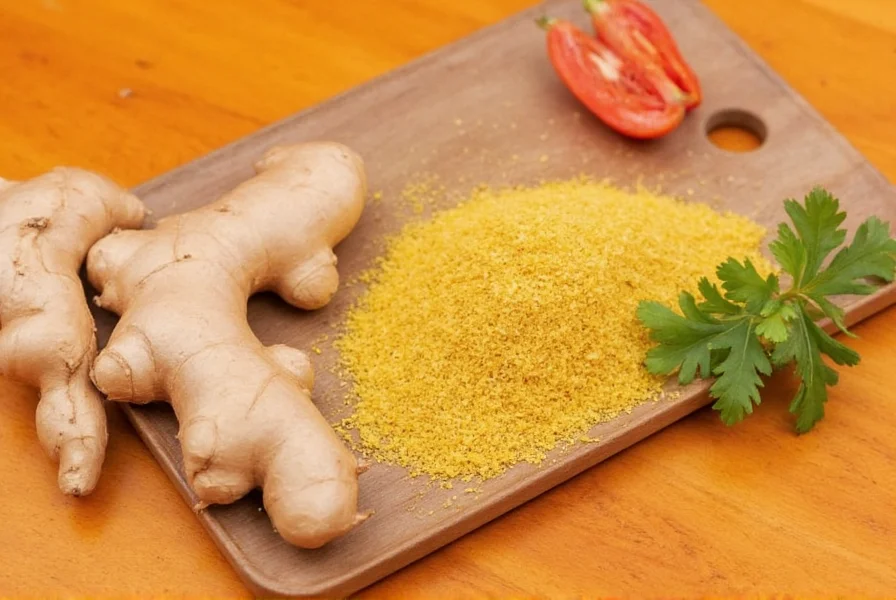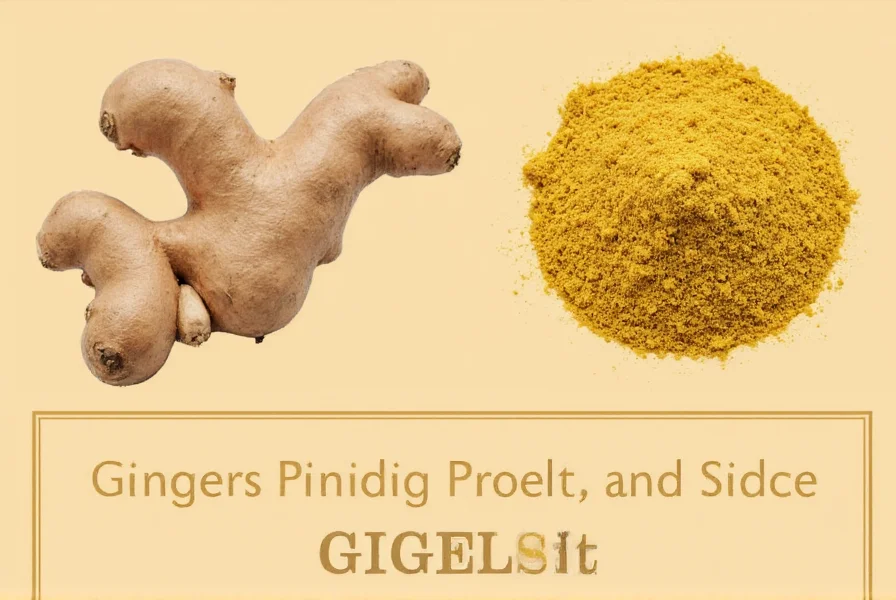Ginger isn't just another spice sitting quietly in your pantry—it's a culinary powerhouse with a 3,000-year history of global use. This knobby rhizome (often mistakenly called a root) delivers a complex flavor journey from sharp and fiery when raw to mellow and sweet when cooked. Understanding ginger's unique properties helps home cooks and professional chefs alike unlock its full potential across countless recipes.
What Exactly Is Ginger?
Botanically classified as Zingiber officinale, ginger belongs to the Zingiberaceae family, sharing relations with turmeric and cardamom. Unlike true roots, ginger grows horizontally underground as a rhizome—essentially a modified stem that stores nutrients. The most common variety, Jamaican ginger, features pale yellow flesh beneath tan skin, though Indian and African varieties often display deeper yellow hues.
Three primary forms dominate culinary applications:
| Form | Characteristics | Best Uses |
|---|---|---|
| Fresh Ginger | Sharp, citrusy heat; fibrous texture | Stir-fries, marinades, fresh juices |
| Dried Ground Ginger | Milder, warmer, more earthy | Baking, spice blends, chai |
| Candied Ginger | Sweet with lingering heat | Desserts, trail mix, tea infusions |
Flavor Chemistry: Why Ginger Stands Out
Ginger's signature bite comes primarily from gingerol, which transforms into zingerone when heated (creating that familiar warm spice) and shogaol when dried (intensifying the heat). This chemical evolution explains why fresh ginger behaves differently in recipes than powdered versions. When substituting between forms, remember that 1 tablespoon fresh ginger equals approximately 1/4 teaspoon ground ginger—a crucial ratio for perfect ginger spice balance in baking.
Ginger Across Global Cuisines
No single culture owns ginger—it's a truly global spice with distinct applications worldwide:
- Asian cooking: Forms the "holy trinity" with garlic and scallions in stir-fries; essential in Japanese gari (pickled ginger)
- Indian cuisine: Key component in ginger-garlic paste and garam masala blends
- Caribbean dishes: Provides backbone for jerk seasoning and sorrel drinks
- Middle Eastern recipes: Features in baharat spice mixtures and date syrups
- European baking: Stars in gingerbread, speculaas, and Scandinavian pea soup

Strategic Spice Pairings
Ginger plays exceptionally well with other spices, but certain combinations create magic. Understanding how to pair ginger with complementary spices elevates your dishes from ordinary to extraordinary:
- Ginger + Turmeric: Creates earthy warmth perfect for golden milk and curries
- Ginger + Cinnamon: The classic duo for baked goods and chai blends
- Ginger + Cardamom: Adds complexity to Middle Eastern rice dishes
- Ginger + Chili: Builds layered heat in Szechuan and Jamaican jerk sauces
- Ginger + Allspice: Essential for authentic Caribbean flavor profiles
When creating your own custom ginger spice blends, start with a 3:1 ratio of ginger to supporting spices, then adjust to taste. Remember that dried spices benefit from toasting before grinding to maximize flavor release.
Fresh vs. Dried: When to Use Which Form
The form of ginger you choose dramatically impacts your final dish. Fresh ginger provides bright, acidic notes ideal for raw applications like dressings and marinades. Its enzymatic properties also help tenderize proteins—a secret weapon for ginger spice marinades that transform tough cuts.
Dried ginger offers more concentrated, rounded warmth better suited for baking and slow-cooked dishes. Ground ginger dissolves completely, distributing flavor evenly, while crystallized ginger adds textural contrast in desserts. For the most complex flavor development, many professional chefs use both forms in the same recipe—fresh for brightness early in cooking, dried for depth later.
Evidence-Based Health Considerations
While not a substitute for medical treatment, ginger contains compounds studied for various wellness applications. Research suggests ginger may support digestive comfort, particularly for occasional nausea. The same gingerol compounds responsible for its heat also contribute antioxidant properties. When incorporating ginger for health-conscious spice applications, fresh forms generally contain higher concentrations of active compounds than dried versions.
Important note: These observations reflect general wellness applications, not medical claims. Always consult healthcare providers for health concerns rather than relying on dietary changes alone.
Practical Selection and Storage Guide
Choose ginger rhizomes that feel heavy for their size with smooth, tight skin—avoiding wrinkles or soft spots that indicate age. Store unpeeled ginger in the refrigerator's crisper drawer for up to three weeks, or freeze whole pieces for six months. For preserving ginger spice potency long-term, peel and store in vodka (which extracts flavor while preventing spoilage) or vacuum-seal grated ginger in ice cube trays.

Innovative Culinary Applications
Move beyond basic uses with these creative approaches to maximizing ginger spice potential:
- Infuse simple syrup with ginger for cocktails and desserts
- Add grated ginger to fruit salads for brightness
- Create ginger oil by steeping in neutral oil over low heat
- Grate frozen ginger directly into sauces for even distribution
- Use ginger in savory fruit chutneys for cheese boards
Professional chefs often employ the "bloom" technique—sautéing ginger in oil at the beginning of cooking—to deepen its flavor profile before adding other ingredients. This simple step transforms ginger and spice combinations from one-dimensional to complex.
Conclusion: Embracing Ginger's Versatility
Ginger's journey from ancient Asian medicine to global kitchen staple proves its unmatched versatility. Whether you're crafting delicate pastries or fiery curries, understanding ginger's properties helps you wield this spice with confidence. By mastering ginger spice selection and application techniques, you unlock a world of flavor possibilities that elevate everyday cooking into something extraordinary. Keep a knob of fresh ginger in your kitchen—it might just become your most reaching-for spice.
What's the difference between ginger root and ginger spice?
Ginger "root" is actually a rhizome (underground stem). Fresh ginger refers to the whole rhizome, while ginger spice typically means dried and ground ginger. Fresh offers bright, sharp heat; dried provides warmer, mellower flavor. They're not interchangeable cup-for-cup in recipes due to concentration differences.
Can I substitute ground ginger for fresh in recipes?
Yes, but with caution. Use 1/4 teaspoon ground ginger for every tablespoon of fresh ginger called for. Remember that ground ginger lacks the bright, citrusy notes of fresh, so it won't provide identical flavor—best for baking or slow-cooked dishes rather than raw applications.
Which spices pair best with ginger for savory dishes?
Ginger harmonizes beautifully with garlic, chili, turmeric, and black pepper in savory applications. For Asian dishes, combine with soy sauce and sesame oil; for Indian cuisine, pair with cumin and coriander; in Caribbean cooking, blend with allspice and thyme. The key is balancing ginger's heat with complementary warm spices.
How can I reduce ginger's strong flavor if I've added too much?
To mellow excessive ginger flavor, add acidic components like lemon juice or vinegar, which counteract spiciness. Dairy (coconut milk, yogurt) or sweetness (honey, brown sugar) also helps balance intense ginger heat. For future reference, grate ginger finely and sauté briefly to moderate its potency before incorporating into dishes.
Frequently Asked Questions
- What's the difference between ginger root and ginger spice? Ginger "root" is actually a rhizome. Fresh ginger offers bright, sharp heat while dried ginger provides warmer, mellower flavor. They're not interchangeable cup-for-cup due to concentration differences.
- Can I substitute ground ginger for fresh in recipes? Use 1/4 teaspoon ground ginger for every tablespoon of fresh. Ground lacks fresh ginger's bright notes, so it works best in baking or slow-cooked dishes rather than raw applications.
- Which spices pair best with ginger for savory dishes? Ginger works well with garlic, chili, turmeric, and black pepper. For Asian dishes, combine with soy sauce; for Indian cuisine, pair with cumin; in Caribbean cooking, blend with allspice.
- How can I reduce ginger's strong flavor if I've added too much? Add acidity (lemon juice), dairy (coconut milk), or sweetness (honey) to balance intense ginger heat. Next time, sauté grated ginger briefly to moderate its potency.











 浙公网安备
33010002000092号
浙公网安备
33010002000092号 浙B2-20120091-4
浙B2-20120091-4